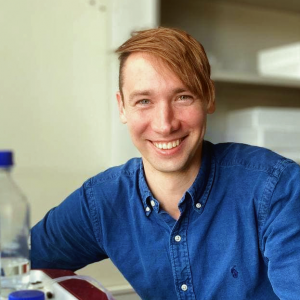
Dmitry’s group is investigating protein molecular machines to discover, design and develop better antimicrobials.
He is using structural biology methods, mostly cryo-electron microscopy, to study how peptide antibiotics are synthesised, transported and how they interact with their targets.
Currently the group focusses on four main themes:
1 – Biosynthesis and mode of action of thiazole-oxazole containing peptidesNatural products produced by bacteria form the basis of the modern medicine chemical arsenal, including antibiotics.
In recent years thousands of new natural products were bioinformatically predicted belonging to the group of RiPPs – ribosomally-synthesised post-translationally modified peptides. These are made as precursor peptides by the ribosome and later enzymatically converted into chemically diverse bioactive molecules.
The Ghilarov lab is particularly interested in the functions of one group of such modification enzymes called YcaO, which activate peptide bonds using ATP to introduce azole rings, thioamides or amidine links into peptides; the details of the YcaO mechanism and selectivity are not known. The possibility to harness YcaO’s ability to modify bespoke peptides will be of huge advantage to biotechnology and medicine
2 – Structure and function of antibacterial peptide transporters.
Together with Dr Konstantinos Beis from Imperial College London Dr Ghilarov’s group is studying molecular mechanisms of membrane transporters required to shuffle antibacterial peptides in and out of cell, and how the peptides are selectively recognised by these transporters. This knowledge is important to design new drugs which escape known resistance mechanisms.
3 – Peptide inhibitors of a bacterial type II topoisomerase, DNA gyrase.
In partnership with the Maxwell lab Dmitry’s group is using cryo-electron microscopy to determine structures of peptide and protein inhibitors of a bacterial topoisomerase DNA gyrase, an established drug target.
4 – Mechanism of transmissible fluoroquinolone resistance protein factors QnrB1 and MfpA Dr Ghilarov’s group is using cryo-electron microscopy to investigate how proteins interacting with DNA gyrase can rescue it from fluoroquinolone antibiotics, leading to resistance.
Selected Publications
-
Michalczyk E, Hommernick K, Behroz I, Kulike M, Pakosz-Stepien Z, Mazurek L, Seidel M, Kunert M, Santos K, von Moeller, Loll B, Weston JB, Mainz A, Heddle JG, Süssmuth RD, Ghilarov (2023)Molecular mechanism of topoisomerase poisoning by the peptide antibiotic albicidin.Nature catalysisPublisher's version: 2520-1158
-
Mazurek L,Ghilarov D,Michalczyk E,Pakosz Z,Metelev M,Czyszczon W,Wawro K,Behroz I,Dubiley S,Süssmuth RD,Heddle JG (2021)Pentapeptide repeat protein QnrB1 requires ATP hydrolysis to rejuvenate poisoned gyrase complexes.Nucleic acids researchPublisher's version: 0305-1048
-
Ghilarov D, Inaba-Inoue S, Stepien P, Qu F, Michalczyk E, Pakosz Z, Nomura N, Ogasawara S, Walker GC, Rebuffat S, Iwata S, Heddle JG, Beis (2021)Molecular mechanism of SbmA, a promiscuous transporter exploited by antimicrobial peptides.Science advancesPublisher's version: 2375-2548
